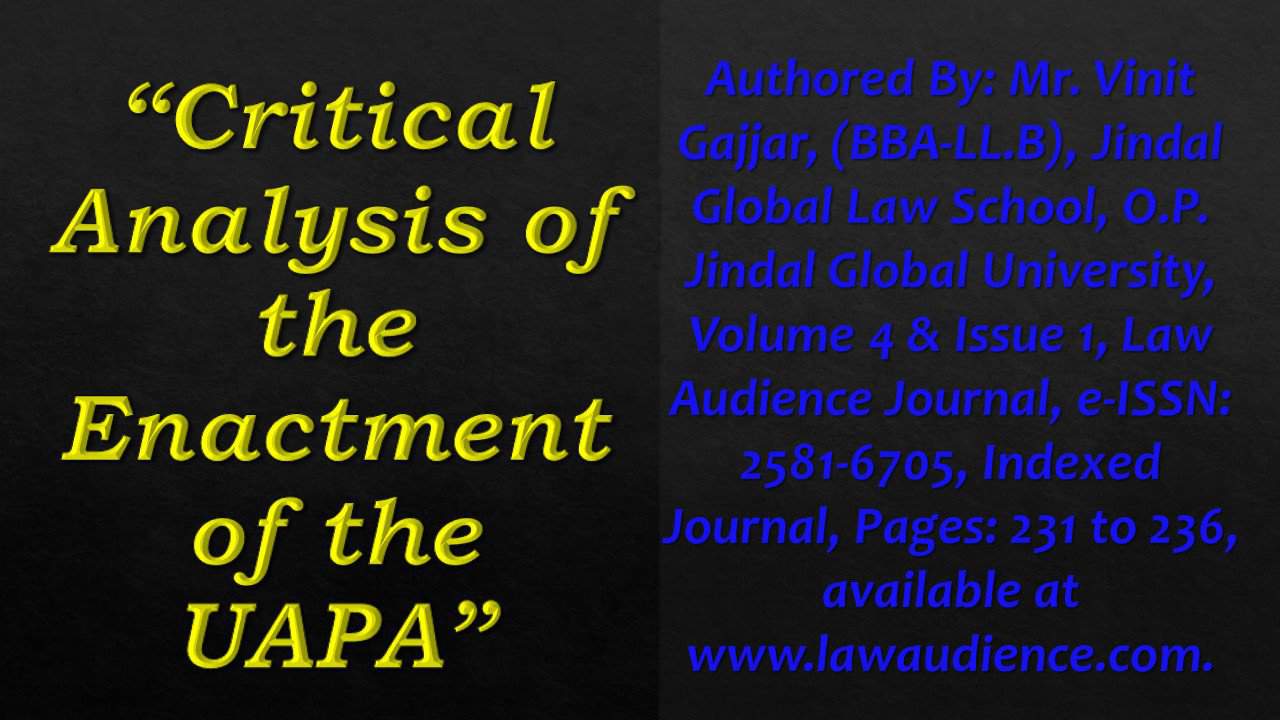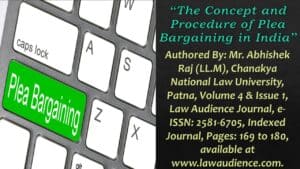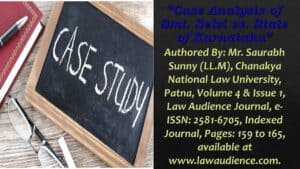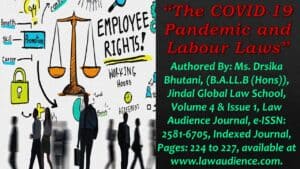Click here to download the full paper (PDF)
Authored By: Mr. Vinit Gajjar, (BBA-LL.B), Jindal Global Law School, O.P. Jindal Global University,
Click here for Copyright Policy.
“Terrorism is one of these manifestations. Violence and crime constitute a threat to an established order and are a revolt against a civilised society. Terrorism is the height of revolt against civilised society. It is because of this hard reality that it is not possible to give a precise definition of terrorism or lay down what constitutes terrorism.”[1]
CRITICAL ANALYSIS OF THE ENACTMENT OF THE UAPA:
The anti-terror laws at present are governed by the Unlawful Activities (Prevention) Act, 1967; however, before the Act became an anti-terror statute targeting both unlawful and terrorist acts, these laws in India were governed by the Terrorist and Disruptive Activities (Prevention) Act (TADA) and the Prevention of Terrorism Act (POTA). TADA was introduced acting on Mrs. Indira Gandhi’s assassination, however, the legislation swiftly grew across the country and eventually covered 23 states and 2 union territories. With TADA came the concept of quick trials and abridged appeal procedure and allowed for hidden witnesses that severely restricted the accused’s right to cross-examine and defend oneself. TADA’s appeal was in its ability to repress dissent, movements, and minorities through a statute passed by Parliament and approved by the Supreme Court.
The aforementioned was a sunset legislation and was expected to be reviewed and expanded in 1995, however, it was never lived up to. The National Human Rights Commission’s then-Chairman, Justice Ranganath Misra, stated that ‘the statute was a tool of persecution’. It was a “draconian law” that was “incompatible with our cultural norms, legal history, and treaty obligations”.[2] The Prevention of Terrorism Act (POTA) was subsequently enacted in a special joint session of the Parliament in March 2002. The 9/11 attack on the Twin Towers in the USA had triggered a global shift towards ‘more stringent’ anti-terror legislation. The same was furthered by the attack on the Indian Parliament in December of that same year. The Supreme Court of India questioned under which circumstance the definition of “terrorist act” applies. To invoke UAPA, the criminal activity must be committed with the intent as envisaged by Section 15 of the UAPA through the use of such weapons as stated in Section 15(a) and which cause or are likely to result in the offences as mentioned in sections 15(a)(i)-(iv), (b), and (c) (c).[3] The concept of intention while doing an act as opposed to an act that constitutes a terrorist act needs to be analysed. However, we first need to make a distinction between knowledge and intention. Intention is a broader notion than knowledge since every intention encompasses knowledge but not vice versa. It is for this reason that intention is seen as a bigger evil than knowledge, as evidenced by the fact that an intentional act draws harsher penalty than an infraction done with mere knowledge. An accused may murder a person knowingly without meaning to kill him, but if he killed with intent, he unquestionably had the knowledge to kill. If an offence was intended, knowledge as a component of that offence is assumed. However, if there is indication that a person committed a crime with knowledge, intention cannot be assumed because he may have done so with or without intent.[4]
As seen in the Nalini case[5], The court reasoned that ‘the accused must have been aware that police officers and Rajiv Gandhi supporters would be killed, but the accused didn’t intend to kill them.’ Legally, they knew their crime would result in the death of several people, but they did not plan to murder them.’ In this instance, the court ruled that “there is simply no proof that any of the conspirators ever intended the death of any Indian other than Rajiv Gandhi.” Except for the assassin herself, no one in the sequence of confessions given by a record number of defendants in any one case, as in this case, has said that anybody had the desire or intention to murder anyone else in addition to Rajiv Gandhi. As a result, the court found no proof beyond a reasonable doubt, and the confessional remarks were insufficient to indicate that the accused meant to terrorise the public or any segment of the public. The idea of intention and knowledge drives a significant portion of reasons behind this decision. It appears that the two terrorism cases, the Nalini case and the Parliament Attack case, have at least one element in common, that is the judicial delineation U turn[6]. This is evident when the court in the former case of Rajiv Gandhi, could not find the attack to be a terrorist act, whereas in the latter case, the court not only found the attack to be a terrorist act but also made a conscious remark on the conduct of the suspect, which is a rare feature in the Supreme Court judgments in India. In the instance of the Parliament Attack, one may say that because the Government of India refuses to relinquish its claim to Kashmir, the people have developed animosity for the government. As a result, there was an attack on Parliament, although it was a matter of personal enmity rather than a terrorist crime. Interestingly, the Supreme Court of India’s in the Parliament Attack case did not get caught up in the creative arguments of the defence counsels. It determined that the attack was carried out by terrorists. It resolved to declare war on India. Furthermore, it used its wisdom to criticise one accused for his suspicious behaviour, who had to be acquitted due to a lack of full proof evidence, as required by criminal jurisprudence.
The nature of anti-terror legislations has been very well noticed by the SC in the landmark Kartar Singh case, The Supreme Court admitted the fact of the criminal justice system that:
“… the Act tends to be very harsh and drastic containing the stringent provisions and provides minimum punishments and to some other offences enhanced penalties also. The provisions prescribing special procedures aiming at speedy disposal of cases, departing from the procedures prescribed under the ordinary procedural law… the prevalent ordinary procedural law was found to be inadequate and not sufficiently effective to deal with the offenders indulging in terrorist and disruptive activities…”[7]
The anti-terror legislations demonstrate a bias in favour of untraditional aspects not prevalent in criminal law, such as presumption of guilt and admissibility of confessions before a police officer, which may be readily abused. However, a criminal cannot be labelled as a “terrorist” just to trigger the more draconian provisions of UAPA. In all cases, the Supreme Court ruled that these rules were legally legitimate. It has mostly abstained from adopting a judgement on the desirability of anti-terror legislation since it is a political issue. However, as previously indicated, the National Human Rights Commission opposes anti-terror legislation. Furthermore, because of the serious nature of the offences, the Legislature has made this radical adjustment, resulting in an untraditional bend in the procedure under this law, so that the purpose of the legislation is not defeated and negated.
The Court’s consciousness of its function in anti-terror proceedings is that it must strike a balance between national security considerations and preservation of Fundamental Rights. As a result, in Shaheen Welfare Association[8], the Court stated that, “while the liberty of a citizen must be zealously protected by the courts, the courts, in dispensing justice in cases such as the one under the TADA Act, should keep in mind not only the liberty of the accused, but also the interests of the victim and their near and dear, and above all, the collective interest of the community and the safety of the nation, so that the public does not lose faith in the system of justice.” Similarly, in the People’s union of democratic rights case [9], the Court recognised the importance of human rights protection and promotion in the battle against terrorism, but also characterised terrorism as an “attack on basic rights.” In light of this, it thought it had a “difficult balance” to strike between defending “‘fundamental’ human rights” and State action in combating terrorism.
However, the notion of terror resulting from an act and an act intended to cause terror and whether both should be penalised as a terrorist act is absurd since the anti-terror legislation is very vague in our country. This notion would mean treating the parliament attack in the same way as someone who is alleged to possess ‘Maoist literature’ as seen in the case of Surendra Pundlik Gadling case[10] (and many more). Moreover, the UAPA can be abused by the Police officers since the act grants special powers. For instance, in Gujarat in 2002, the state government filed POTO charges against 62 Muslims (which included seven juveniles) for their involvement in the Godhra scandal. POTA charges were restored against 121 persons a year after they were withdrawn owing to public outrage. However, no one was ever prosecuted with terrorism in connection with the ensuing widespread violence and brutality directed towards minorities.[11] According to studies, the Prevention of Terrorism Act was used for political retaliation and persecution in Andhra Pradesh and Jharkhand. POTA charges were filed in both jurisdictions for political activity or caste and tribal status rather than criminal behaviour.[12]
Using a jurisprudential perspective, the normative ideology of minimalism promotes the ideals of clarity, consistency, adherence to legal norms, and democratic debate in adjudication. Minimalism is presented as a means of reconciling judicial power with democratic principles. The minimalist model believes that the judiciary should defer to the political branches as much as feasible, but that where this is not practicable, the judicial function should be confined to settling the small disagreement between the parties, leaving wider concerns available for democratic settlement. Sunstein refers to this method as the democracy-protecting minimalism strategy. He also advises the court to not just refrain from interfering in democratic debates, but to actively determine in a way that fosters democratic discourse. This strategy promotes democracy by focusing on the content of court judgements and favouring outcomes that strengthen democratic discourse. As a result, Sunstein supports for the repeal of laws and activities that do not follow methods designed to maintain and strengthen democratic discourse, such as non-application of mind, vagueness, excessive delegation, and mala fides, and so on, which is exactly what anti-terror legislation in our country can be considered.[13]
It is well-established that there are not any diverging opinions regarding the fight against terrorism. As all the people in the nation stand united against this issue. During the British Raj, Indians were expected to obey draconian laws. This hasn’t altered much since the country’s independence. TADA (since lapsed) and POTA (now repealed) passed by Indian lawmakers after India’s independence were harsh in that state agents efficiently use it to undermine individual liberty and fundamental rights. Laws are rehashed versions of themselves. There have been instances where the Supreme Court quashed a law and Parliament enforced another with harsher provisions, or when the government struck down one law and bolstered it with another that is more draconian and heinous than its predecessor; in this sense, the repeal of POTA in 2004 was mere puffery because the majority of its provisions were incorporated into the UAPA act through an amendment in 2008. While the judges upheld the legitimacy of TADA and POTA, they had already separated anti-terror measures from the criminal justice system – as a kind of ‘public order plus,’ an excess of legislation that could not possibly cope with the size of the terrorist issue alone. In rare instances, the government establishes laws such as the UAPA, which allows the government to label a person as a terrorist providing little safeguards in return.
The law further gives power to prosecute people when it is thought that their actions are against the interests of the country. Such revisions to anti-terror laws are antithetical to the principles of a democratic state and the maintenance of the rule of law. Therefore, it is necessary to conceive these anti-terror laws in terms of what they profess to oppose and what they really combat, since India’s experience with these laws demonstrates that what they safeguard is the power of the governing regime to circumvent human rights. With the purported procedural fairness and emphasis on “objective review of evidence” rather than administrative decision making, the UAPA seeks to be more analogous to a criminal justice system than a preventive detention regime. But it lives on paranoia and a sense of menace.[14]
Cite this article as:
Mr. Vinit Gajjar, “Critical Analysis of the Enactment of the UAPA”, Vol.4 & Issue 1, Law Audience Journal (e-ISSN: 2581-6705), Pages 231 to 236 (8th July 2022), available at https://www.lawaudience.com/critical-analysis-of-the-enactment-of-the-uapa/.
Footnotes & References:
[1]2 RMLNLUJ (2010) 97.
[2]Justice RanganathMisra, Annual Report 1994-95, NATIONAL HUMAN RIGHTS COMMISSION (1995),
http://www.rwi.lu.se/NHRIDB/Asia/India/Annual%20Report%2094-95.pdf.
[3]Unlawful Activities (Prevention) Act, 1967.
[4]Indian Penal Code, 1860, Section 304 maintains this distinction.
[5](1999) 5 SCC 253.
[6]2 RMLNLUJ (2010) 97.
[7](1994) 3 SCC 569.
[8]1996 SCC (2) 616.
[9](2004) 9 SCC 580.
[10] (2019)5 SCC OnLine SC 188.
[11]ManojMitta, The Fiction of Fact-Finding : Modi and Godhra (2014).
[12]Anil Kalhan et al., Colonial Continuities : Human Rights, Terrorism and Security Laws in India, 20(1) COLUM.J.ASIAN L. 148, 174 (2005).
[13]SUNSTEIN, supra note 8, at 3-4. See also, See, Christopher J. Peters, Assessing the New Judicial Minimalism,
100 Colum. L. Rev. 1454, 1456 (2000), at 1463.
[14]Yadav, D., 2019. NIA Amendment Raises Concerns Of Misuse Of Anti-Terror Laws. [online] Livelaw.in. Available at: <https://www.livelaw.in/columns/niaamendment-anti-terror-laws-146552> [Accessed 17 April 2022].




